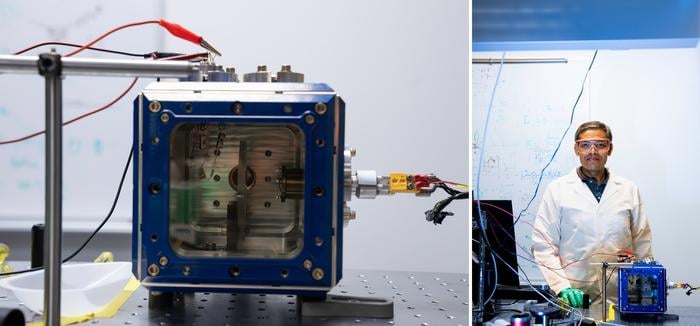Quantum Physics Suggests More Efficient Way to Convert Industrial Heat to Electricity
Rice University researchers have developed a new way to capture waste heat from industrial processes, which could save billions in energy costs. Their quantum-inspired design could help make thermal energy storage a viable alternative to batteries for grid-scale applications.
Published in npj Nanophotonics | Estimated reading time: 5 minutes
In a world where nearly half of industrial heat is wasted, costing the U.S. economy more than $200 billion annually, finding better ways to capture and reuse this energy has become important. Now, scientists at Rice University have taken an unusual approach to this challenge, drawing inspiration from quantum physics to create a more efficient way to convert heat into electricity.
The breakthrough centers on developing thermophotovoltaic (TPV) devices, which convert heat into electricity through light. The team focused on improving the heat emitter – the part that converts heat into light – to achieve efficiency levels above 60% while maintaining efficient operation.
Gururaj Naik, assistant professor at Rice University, explains: “Using conventional design methods reduces the design space of heat emitters.” “What you end up with is one of two situations: active, inefficient devices or efficient emitters that are difficult to integrate into real-world applications.”
The band’s new design uses a tungsten metal sheet embedded with silicon nanocylinders and a thin spacer layer. This arrangement allows the system to precisely control how photons – particles of light – are captured and released, increasing the energy conversion efficiency.
The implications of this development extend beyond the industrial context. The technology could make thermal energy storage a viable alternative to lithium-ion batteries for grid-scale applications, especially where long-term energy storage is needed. It could also acquire space probes, which could provide power to Mars.
“If our approach can lead to an increase in efficiency from 2% to 5% in such systems, that would represent a significant boost for missions that rely on efficient energy production in extreme environments ,” says Naik, drawing from his experience working with NASA. .
As industries around the world seek to reduce their impact on the environment while maintaining productivity, technologies that can recover and use waste heat are becoming increasingly important. This development brings us closer to an energy-efficient industrial future.
Glossary:
- Thermophotovoltaic (TPV) systems.
- Technology that converts heat into electricity by first converting heat into light, which is then captured by photovoltaic cells.
- Thermal Emitter
- A component that converts heat into light in a TPV system.
- Nanocylinders
- Microscopic cylindrical structures that help control the release of light particles into the system.
What percentage of industrial heat is wasted now?
Between 20-50% of industrial heat used in production processes is wasted.
What level of efficiency is achieved by the new heating system?
The thermal emitter has achieved efficiency levels above 60% while working for real-world applications.
What are the key features of a new heat emitter design?
The design uses a tungsten metal sheet, a thin spacer layer, and a network of silicon nanocylinders.
How can this technology help space exploration?
It can increase power generation efficiency from 2% to 5% for applications such as Mars rovers operating in extreme conditions.
Enjoyed this story? Subscribe to our newsletter
Related
#Quantum #Physics #Suggests #Efficient #Convert #Industrial #Heat #Electricity
